Olga's Gallery
We were horrified and outraged by Tuesday's catastrophe. We bring our
condolences to all those who lost loved ones in the tragedy, although we
can never understand the suffering felt by the victims of the horrific
event. Our thoughts and prayers are with them.
Flemish School of Painting
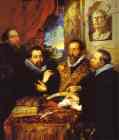 Without any doubt, the central figure of XVII century Flemish art was
Peter
Paul Rubens, the greatest European artist of his time, who introduced
a new style, the Baroque, and had a powerful and lasting effect on European
art. Rubens was born in 1577 in the former German principality of Nassau,
into a family of Flemish protestant refugees and died in Antwerp in 1640.
This extraordinarily productive artist not only created many works – in
different sources we found that from 1,200 up to 3,600 paintings are attributed
to him – but also produced an enormous variety. The most important themes
and subjects of this genius include religious, allegorical and mythological
scenes, portraits, hunting scenes and landscapes.
Without any doubt, the central figure of XVII century Flemish art was
Peter
Paul Rubens, the greatest European artist of his time, who introduced
a new style, the Baroque, and had a powerful and lasting effect on European
art. Rubens was born in 1577 in the former German principality of Nassau,
into a family of Flemish protestant refugees and died in Antwerp in 1640.
This extraordinarily productive artist not only created many works – in
different sources we found that from 1,200 up to 3,600 paintings are attributed
to him – but also produced an enormous variety. The most important themes
and subjects of this genius include religious, allegorical and mythological
scenes, portraits, hunting scenes and landscapes.

 Rubens
had a great influence on other painters with whom he often collaborated.
Practically all the Flemish painters from the first half of the XVII century
can be related to Rubens in some way. The majority of these artists were
completely overshadowed by the great master. Only a few have gone down
in history of art as important masters. This certainly applies to Anthony
van Dyck (1599-1641), who died at a young age but his career was comparable
to that of Rubens. Van Dyck is sometimes called an apprentice of Rubens,
though in reality they got acquainted and became friends when Van Dyck
was already a master painter. They worked together between 1617 and 1621,
and it looks that in Rubens’ studio Van Dyck did not paint any special
subjects, as it was with other Rubens’ collaborators and friends, e.g.
Jan
Brueghel the Elder (1568-1625), who was specially asked to paint garlands
of flowers, and background landscapes and animals.
Rubens
had a great influence on other painters with whom he often collaborated.
Practically all the Flemish painters from the first half of the XVII century
can be related to Rubens in some way. The majority of these artists were
completely overshadowed by the great master. Only a few have gone down
in history of art as important masters. This certainly applies to Anthony
van Dyck (1599-1641), who died at a young age but his career was comparable
to that of Rubens. Van Dyck is sometimes called an apprentice of Rubens,
though in reality they got acquainted and became friends when Van Dyck
was already a master painter. They worked together between 1617 and 1621,
and it looks that in Rubens’ studio Van Dyck did not paint any special
subjects, as it was with other Rubens’ collaborators and friends, e.g.
Jan
Brueghel the Elder (1568-1625), who was specially asked to paint garlands
of flowers, and background landscapes and animals.
 Another friend of Rubens and specialist in the studio was Frans
Snyders (1579-1657), who was an excellent painter of still lifes and
animals.
Another friend of Rubens and specialist in the studio was Frans
Snyders (1579-1657), who was an excellent painter of still lifes and
animals.
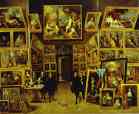 In the circle of acquaintances of the great master entered Jan Brueghel’s
son-in-law, David Teniers the Younger
(1610-1690). In his own time, Teniers was an exceptionally successful landscape,
genre and portrait painter. One of his paintings, The Art Collection
of Archduke Leopold Wilhelm in Brussels, of which several variations
exist, gives a good impression of the sort of collection owned by a nobleman
at that time. The influence of Rubens can be discerned in Teniers’ later
work.
In the circle of acquaintances of the great master entered Jan Brueghel’s
son-in-law, David Teniers the Younger
(1610-1690). In his own time, Teniers was an exceptionally successful landscape,
genre and portrait painter. One of his paintings, The Art Collection
of Archduke Leopold Wilhelm in Brussels, of which several variations
exist, gives a good impression of the sort of collection owned by a nobleman
at that time. The influence of Rubens can be discerned in Teniers’ later
work.
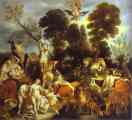
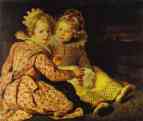 Jacob
Jordaens (1593-1678) married the daughter of Adam van Noort, one of
Rubens’ teachers. This Flemish painter was esteemed so highly that he received
all the biggest commissions after the deaths of Rubens in 1640, and of
Anthony van Dyck in 1641. Together with the brother-in-law of Snyders,
Cornelis de Vos (1584-2651), and a number
of other Flemish painters, Jordaens produced the festive decorations designed
by Rubens for the official entry of the Cardinal-Infant Archduke Ferdinand
into Antwerp in 1635. Jordaens also collaborated with Rubens on the paintings
for the hunting lodge of the King of Spain. Jordaens was famous as a genre
painter and was particularly popular for his vivid scenes from the lives
of the common people of Flanders.
Jacob
Jordaens (1593-1678) married the daughter of Adam van Noort, one of
Rubens’ teachers. This Flemish painter was esteemed so highly that he received
all the biggest commissions after the deaths of Rubens in 1640, and of
Anthony van Dyck in 1641. Together with the brother-in-law of Snyders,
Cornelis de Vos (1584-2651), and a number
of other Flemish painters, Jordaens produced the festive decorations designed
by Rubens for the official entry of the Cardinal-Infant Archduke Ferdinand
into Antwerp in 1635. Jordaens also collaborated with Rubens on the paintings
for the hunting lodge of the King of Spain. Jordaens was famous as a genre
painter and was particularly popular for his vivid scenes from the lives
of the common people of Flanders.
 The
live of the people was also the central subject of the work of Adriaen
Brouwer (c. 1606-1638), who died at a young age. Both Rembrandt
and Rubens highly esteem this artist and owned some of his works.
The
live of the people was also the central subject of the work of Adriaen
Brouwer (c. 1606-1638), who died at a young age. Both Rembrandt
and Rubens highly esteem this artist and owned some of his works.
At the end of the XVI century Antwerp masters developed the still life as an independent genre. Throughout the XVII century it spread from there to the north and became extremely popular. During this period several hundred Flemish and Dutch painters specialized in this genre, which produced countless masterworks of technical perfection and virtuosity. The early still lifes were not a casual (accidental) combination of objects, each item and each flower had its own symbolic meaning, and on the whole the ready painting was meant to say something important to the views. Unfortunately, we can’t read these symbols any longer, the symbols are often hidden from contemporary eyes.
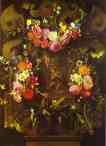 For
example, the still lifes of flowers by Daniel
Seghers (1590-1661), an apprentice of Jan Brueghel, should not be seen
merely as botanical studies either. In fact, the flowers in the foreground
are trying to comment the religious scenes in the background.
For
example, the still lifes of flowers by Daniel
Seghers (1590-1661), an apprentice of Jan Brueghel, should not be seen
merely as botanical studies either. In fact, the flowers in the foreground
are trying to comment the religious scenes in the background.
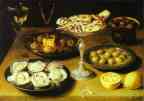 Only
8 works of the last of the early Flemish still life painters have survived,
Ossias Beert (1570-1624?).
These were the precursors of a type of ornamental still life that became
very popular in Holland, later known by the term Breakfast. Beert’s works
are also full of symbols.
Only
8 works of the last of the early Flemish still life painters have survived,
Ossias Beert (1570-1624?).
These were the precursors of a type of ornamental still life that became
very popular in Holland, later known by the term Breakfast. Beert’s works
are also full of symbols.
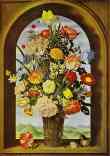 The
Flemish painters played an important role in the appearance of the genre
in the Northern Netherlands. For example, Ambrosius
II Bosschaert (1573-1621) fled from Antwerp to Middleburg because of
his religious beliefs and for the rest of his life he worked in Holland
where he had a great deal of influence. The floral paintings of this early
master of still lifes also have a symbolic meaning.
The
Flemish painters played an important role in the appearance of the genre
in the Northern Netherlands. For example, Ambrosius
II Bosschaert (1573-1621) fled from Antwerp to Middleburg because of
his religious beliefs and for the rest of his life he worked in Holland
where he had a great deal of influence. The floral paintings of this early
master of still lifes also have a symbolic meaning.
“With the still life painters, the golden age of Flemish and old Netherlandish painting came to an end. They were the last masters in an illustrious series of painters who set the tone for the art of northern Europe for two centuries without interruption. However, the prime of painting in the Netherlands was not yet over; the golden century had started, introducing the era of the Dutch masters.”
The end